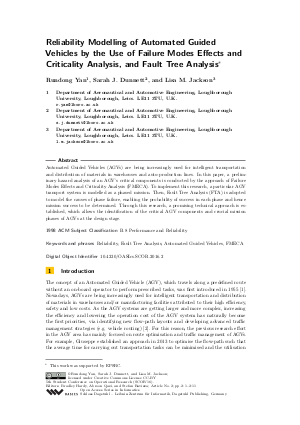Reliability Modelling of Automated Guided Vehicles by the Use of Failure Modes Effects and Criticality Analysis, and Fault Tree Analysis
Authors Rundong Yan, Sarah J. Dunnett, Lisa M. Jackson
-
Part of:
Volume:
5th Student Conference on Operational Research (SCOR 2016)
Part of: Series: Open Access Series in Informatics (OASIcs) - License:
 Creative Commons Attribution 3.0 Unported license
Creative Commons Attribution 3.0 Unported license
- Publication Date: 2016-08-23
File

PDF
OASIcs.SCOR.2016.2.pdf
- Filesize: 0.84 MB
- 11 pages
Document Identifiers
Subject Classification
Keywords
- Reliability
- Fault Tree Analysis
- Automated Guided Vehicles
- FMECA
Metrics
- Access Statistics
-
Total Accesses (updated on a weekly basis)
0PDF Downloads0Metadata Views
Abstract
Automated Guided Vehicles (AGVs) are being increasingly used for intelligent transportation and distribution of materials in warehouses and auto-production lines. In this paper, a preliminary hazard analysis of an AGV's critical components is conducted by the approach of Failure Modes Effects and Criticality Analysis (FMECA). To implement this research, a particular AGV transport system is modelled as a phased mission. Then, Fault Tree Analysis (FTA) is adopted to model the causes of phase failure, enabling the probability of success in each phase and hence mission success to be determined. Through this research, a promising technical approach is established, which allows the identification of the critical AGV components and crucial mission phases of AGVs at the design stage.
Cite As Get BibTex
Rundong Yan, Sarah J. Dunnett, and Lisa M. Jackson. Reliability Modelling of Automated Guided Vehicles by the Use of Failure Modes Effects and Criticality Analysis, and Fault Tree Analysis. In 5th Student Conference on Operational Research (SCOR 2016). Open Access Series in Informatics (OASIcs), Volume 50, pp. 2:1-2:11, Schloss Dagstuhl – Leibniz-Zentrum für Informatik (2016)
https://doi.org/10.4230/OASIcs.SCOR.2016.2
BibTex
@InProceedings{yan_et_al:OASIcs.SCOR.2016.2,
author = {Yan, Rundong and Dunnett, Sarah J. and Jackson, Lisa M.},
title = {{Reliability Modelling of Automated Guided Vehicles by the Use of Failure Modes Effects and Criticality Analysis, and Fault Tree Analysis}},
booktitle = {5th Student Conference on Operational Research (SCOR 2016)},
pages = {2:1--2:11},
series = {Open Access Series in Informatics (OASIcs)},
ISBN = {978-3-95977-004-0},
ISSN = {2190-6807},
year = {2016},
volume = {50},
editor = {Hardy, Bradley and Qazi, Abroon and Ravizza, Stefan},
publisher = {Schloss Dagstuhl -- Leibniz-Zentrum f{\"u}r Informatik},
address = {Dagstuhl, Germany},
URL = {https://drops.dagstuhl.de/entities/document/10.4230/OASIcs.SCOR.2016.2},
URN = {urn:nbn:de:0030-drops-65144},
doi = {10.4230/OASIcs.SCOR.2016.2},
annote = {Keywords: Reliability, Fault Tree Analysis, Automated Guided Vehicles, FMECA}
}
